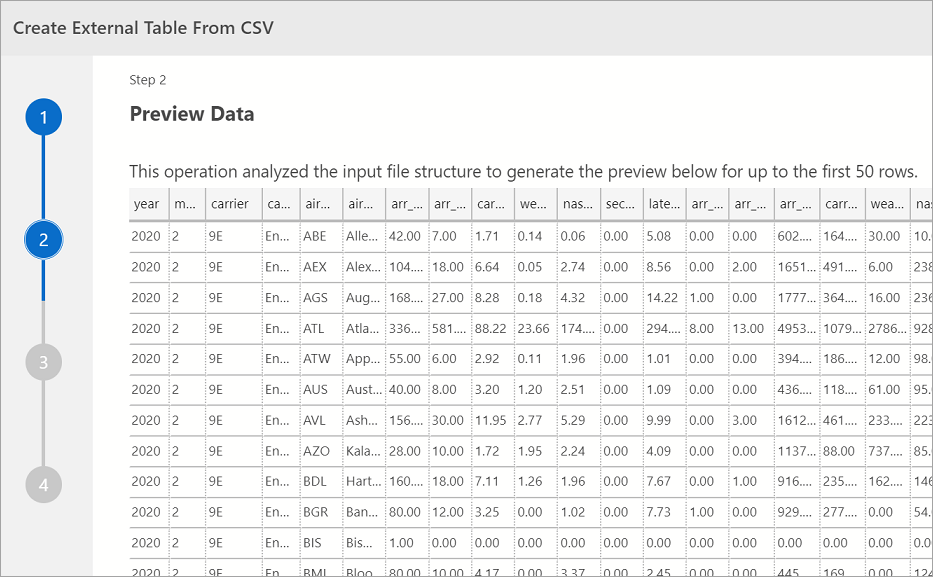Virtualize CSV data from storage pool (Big Data Clusters)
Important
The Microsoft SQL Server 2019 Big Data Clusters add-on will be retired. Support for SQL Server 2019 Big Data Clusters will end on February 28, 2025. All existing users of SQL Server 2019 with Software Assurance will be fully supported on the platform and the software will continue to be maintained through SQL Server cumulative updates until that time. For more information, see the announcement blog post and Big data options on the Microsoft SQL Server platform.
SQL Server Big Data Clusters can virtualize data from CSV files in HDFS. This process allows the data to stay in its original location, but can be queried from a SQL Server instance like any other table. This feature uses PolyBase connectors, and minimizes the need for ETL processes. For more information on data virtualization, see Introducing data virtualization with PolyBase
Prerequisites
Select or upload a CSV file for data virtualization
In Azure Data Studio (ADS) connect to the SQL Server master instance of your Big Data Cluster. Once connected, expand the HDFS elements in the object explorer to locate the CSV file(s) you would like to data virtualize.
For the purposes of this tutorial, create a new directory named Data.
- Right-click on the HDFS root directory context menu.
- Select New directory.
- Name the new directory Data.
Upload sample data. For a simple walk-through, you can use a sample csv data file. This article uses airline delay cause data from the US Department of Transportation. Download the raw data, and extract the data to your computer. Name the file airline_delay_causes.csv.
To upload the sample file after you extract it:
- In Azure Data Studio, right-click the new directory you created.
- Select Upload files.

Azure Data Studio uploads the files to HDFS on the Big Data Cluster.
Create the storage pool external data source in your target database
The storage pool external data source is not created in a database by default in your Big Data Cluster. Before you can create the external table, create the default SqlStoragePool External Data Source in your target database with the following Transact-SQL query. Make sure you first change the context of the query to your target database.
-- Create the default storage pool source for SQL Big Data Cluster
IF NOT EXISTS(SELECT * FROM sys.external_data_sources WHERE name = 'SqlStoragePool')
CREATE EXTERNAL DATA SOURCE SqlStoragePool
WITH (LOCATION = 'sqlhdfs://controller-svc/default');
Create the external table
From ADS, right-click on the CSV file and select Create External Table From CSV File from the context menu. You can also create external tables from CSV files from a directory in HDFS if the files under the directory follow the same schema. This would allow the virtualization of the data at a directory level without the need to process individual files and get a joined result set over the combined data. Azure Data Studio guides you through the steps to create the external table.
Specify the database, the data source, a table name, the schema, and the name for the table's external file format.
Select Next.
Preview Data
Azure Data Studio provides a preview of the imported data.

Once done viewing the preview, select Next to continue
Modify Columns
In the next window, you may modify the columns of the external table you intend to create. You are able to alter the column name, change the data type and allow for nullable rows.

After you verify the destination columns, select Next.
Summary
This step provides a summary of your selections. It provides the SQL Server name, database name, table name, table schema, and external table information. In this step, you have the option to generate a script or create a table. Generate Script creates a script in T-SQL to create the external data source. Create Table creates the external data source.

If you select Create Table, SQL Server creates the external table in the destination database.
If you select, Generate Script, your Azure Data Studio creates the T-SQL query for creating the external table.
Once created the table can now be queried directly using T-SQL from the SQL Server instance.
Next steps
For more information on SQL Server Big Data Cluster and related scenarios, see Introducing SQL Server Big Data Clusters.
Feedback
Coming soon: Throughout 2024 we will be phasing out GitHub Issues as the feedback mechanism for content and replacing it with a new feedback system. For more information see: https://aka.ms/ContentUserFeedback.
Submit and view feedback for